By Lukas Schulte
Trying to decide between the 8mm Mauser vs 308 Winchester? Here’s what you need to know about them.
Numerous rifle cartridges have seen extensive use both in armed conflicts around the world as well as in the hands of hunters. For instance, this list includes classics like the 7×57 Mauser, the 303 British, the .223 Remington (and its cousin the 5x56x45mm NATO), and the .30-06 Springfield. We’d be remiss if we didn’t include the American .308 Winchester and German 8mm Mauser rounds though.
While not identical, the civilian .308 Winchester is closely related to the military 7.62x51mm NATO round.
Both the 308 and 8mm Mauser rounds have proven themselves in combat as highly effective on soft targets out to distances far beyond 500 yards. Both rounds have been used in soldiers primary weapons such as the Mauser k98 bolt action rifle and the M14 battle rifle. Both have been used in heavier machine guns like the German MG 08/15, the MG-34, and MG-42 for the 8mm Mauser as well as the MG-3, M-60 and the M-240 (also known as the FN MAG in Europe) for the 7.62x51mm NATO.
On the civilian side of things, both the .308 Winchester and the 8x57IS (another of the many names of that round) remain favorite cartridges for many hunters heading afield in pursuit of big game animals around the globe.
Though both rounds are pretty old, they remain popular and effective choices for hunting all manner of big game. In fact, you might be surprised by how good these two might work for you.
In this article, I investigate the 8mm Mauser vs 308 Winchester cartridges and provide some insight into which rifle cartridge is ideally suited for various hunting situations so you can make an informed decision on which one will work best for your individual needs.
History Of The 8mm Mauser & 308 Winchester
We’ll start with the older German cartridge here.
The 8mm Mauser first appeared as the Patrone 88 (Patrone is the German word for cartridge) in 1888 alongside the then new Mauser Model 88 rifle. Demanded by the German military commission in 1887, this rifle was a predecessor to the famed and globally known Mauser Model 98.
Realizing the new smokeless 8mm Lebel cartridge in use with the French military had an edge over the German military rounds of the day, such as the 11x60mmR black powder cartridge, leadership of the German Empire demanded a new, higher performing cartridge.
That first incarnation of the 8mm Mauser was loaded with a bit over 40 grains of smokeless powder that pushed a .318″ caliber round nose FMJ bullet weighing 14.7g (around 227 grains) to just over 2,000 fps (2,015 ft-lbs or 2,730J).
This 8x57mm round carried the moniker “infantry” (Infanterie in German), which gave the 8x57I its full, official name (and it’s also sometimes referred to as the 8x57J or the 7x92x57mm).
The “I” was often mistaken for a “J” on behalf of Americans due to the way the letter was written in Germany at the time. For this reason, it’s not uncommon to see the name “8x57J” pop up when someone refers to the cartridge.
The often used surname “Mauser” is rather uncommon in Europe, though some refer to it as the 8mm Mauser due to its close association with Mauser rifles. Mauser did not invent the round himself though.
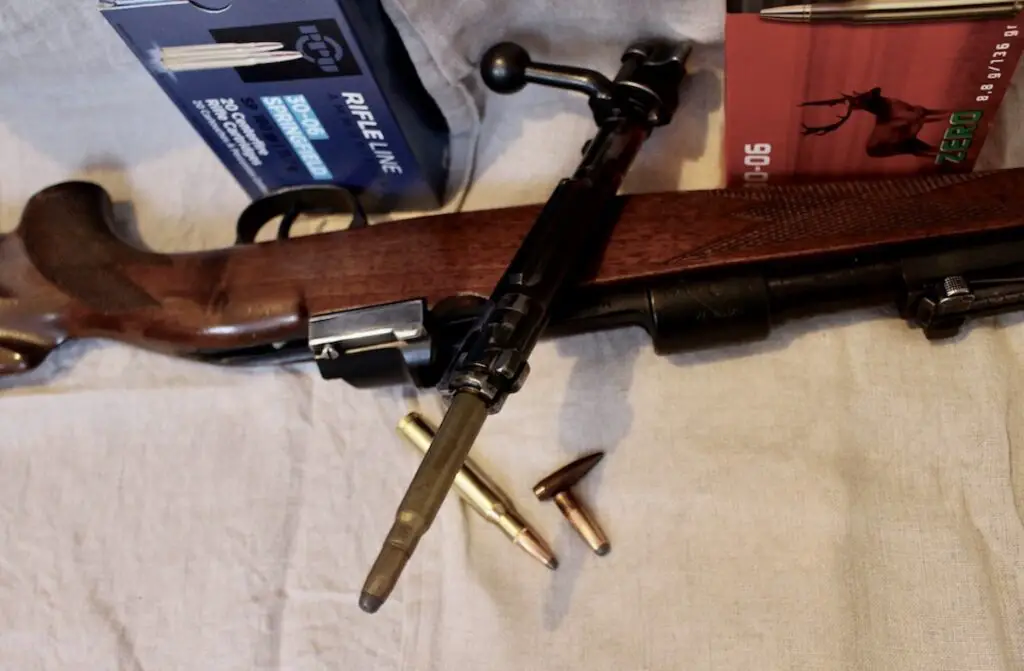
Designers revised the Patrone88/8x57I cartridge in 1905 in an effort to squeeze more performance out of the 98 Mauser rifle.
First, they increased the cartridge bullet diameter from .318″ to .323″.
Second, they adopted a lighter and more aerodynamic 153 grain (9.9g) bullet construction with a sharply pointed tip.
Dubbed the 8x57IS, the latest iteration of the 8mm Mauser carries the new “S” designation both to clearly distinguish between the older and newer versions of the cartridge and to describe the new round. The S in the 8x57IS stands for Spitzer or Stark (the German word for strong).
The new round ditched the inefficient round nose bullet, was loaded to a higher maximum pressure and used more modern powders. With all this in mind, the 8x57IS (also known as the 8x57JS) was thus simply a more powerful cartridge than the old 8x57I. Pushing that 153gr bullet at 2,800fps (878m/s), it had a roughly 37% higher muzzle velocity and 28% more muzzle energy than the old 8x57I.
This is the cartridge the German military used during both World Wars.
Many barrels of the day also shot the slightly larger diameter bullets more accurately. For this reason, many of those older 8x57I rifles were rebarreled to use the newer loads.
Even so, the older 8mm Mauser version never went completely away, so there actually are two rimless 8mm Mauser versions still in use. European hunters usually look at them as related, but two distinct cartridges.
The I-version of this round is pretty rare. Since the 8×57 mm JS has a larger bore diameter than the older 8x57I, it should go without saying that firing the larger diameter bullet in an I-version barrel could be disastrous though.
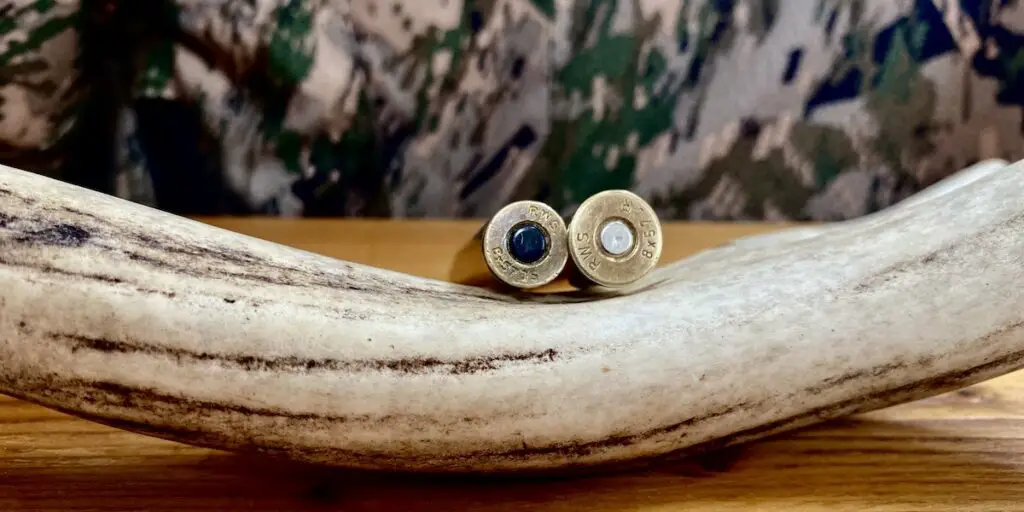
If that weren’t enough, both the I- and the IS-version of the 8mm Mauser have rimmed sister cartridges designed for break action guns such as drillings and that bear the “R” designation to indicate a rimmed case.
Yes, it’s confusing: there are 4 similar, though distinct cartridges in the 8mm Mauser family.
Furthermore, those 4 cartridges are known by 8 different names: the 8x57I and the identical 8x57J, the 8x57IS and the identical 8x57JS, the 8x57IR and the identical 8x57JR, and the 8x57IRS along with the identical 8x57JRS.
The weaker and smaller diameter IR-version (the third variant of the 8mm Mauser) is still in use to this day.
No new weapons are chambered for the older and weaker 8x57JR round, but my father for example inherited a drilling in said round from his father. That gun is in still in use, and members of my family have taken a fair bit of game with it.
The slightly more powerful 8x57JRS is more commonly used to this day.
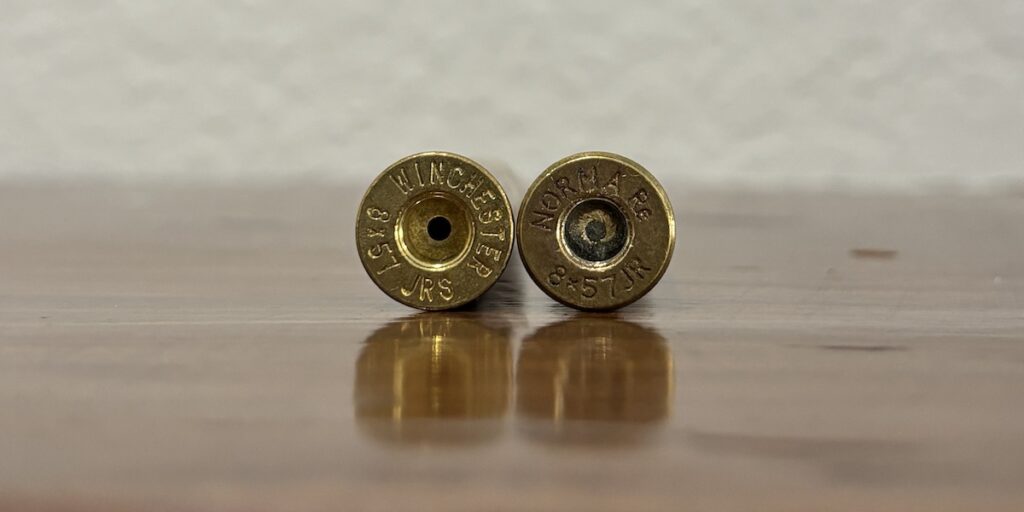
Rimmed siblings of rimless designs are usually loaded to slightly lower pressure, as they’re approved with 5-10% lower maximum chamber pressure. That won’t play much of a role for most hunts. When all is said and done, there are really four different 8mm Mauser cartridges, that are similar, but not identical.
Once you understand the differences, it’s easy to distinguish them and handle them safely.
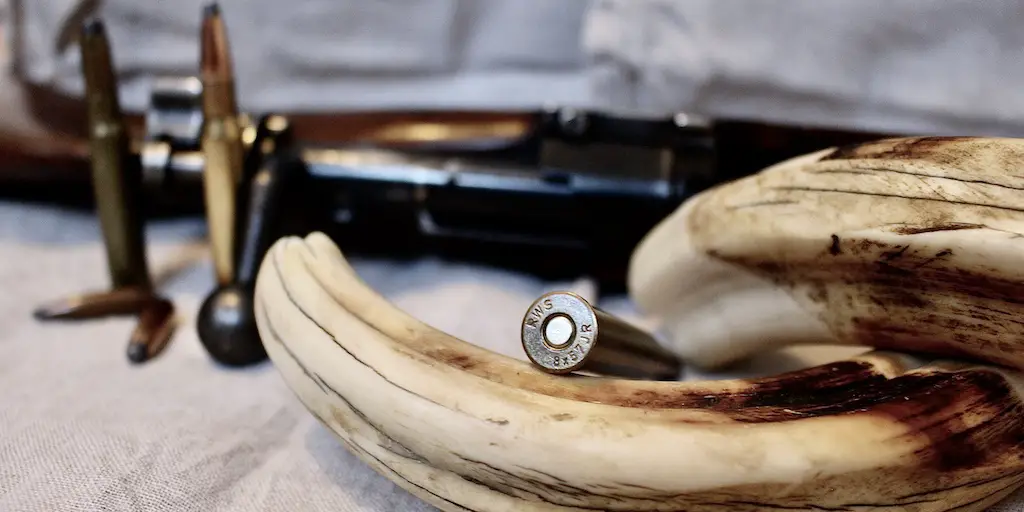
After a few decades of reduced popularity, the 8x57IS is gaining a bit more traction these days. The rise in popularity of silencers in Europe has people asking for shorter barrels, which especially hamstrings many of the more modern, high powered rifle cartridges.
On the other hand, the 8x57mm works great with barrels as short as 18-20 inches.
Now let us take a closer look at the history of the .308 Winchester.
After World War II there was a shift in the desired characteristics of cartridges intended for soldier’s primary weapons. Towards the end of the war, Germany had developed a so called “intermediate cartridge“, the 7.92x33mm, alongside the Sturmgewehr 44, which is often labeled one of the first true assault rifles.
Military leaders realized most of the fighting of infantry soldiers happened within 300m (roughly 330 yards). So, they looked for an alternative with a longer effective range and more power than pistol rounds, which had been used in automatic firearms for close quarters combat before, but without the excess recoil of the 8mm Mauser rifle cartridge.
With an intermediate round that fit into this “sweet spot”, soldiers to carry more ammunition and wouldn’t have to deal with recoil of the 8mm Mauser rifle, but still be able to effectively engage all enemies they would encounter.
The new cartridge and rifle did not change the outcome of the war, but it was nonetheless a revolutionary development and the Soviet Union quickly responded with its own AK 47 and the 7.62x39mm round.
So the United States military decided that it was time to move on from the full length .30-06 Springfield cartridge to the newer and smaller 7.62x51mm NATO in the 1950s.
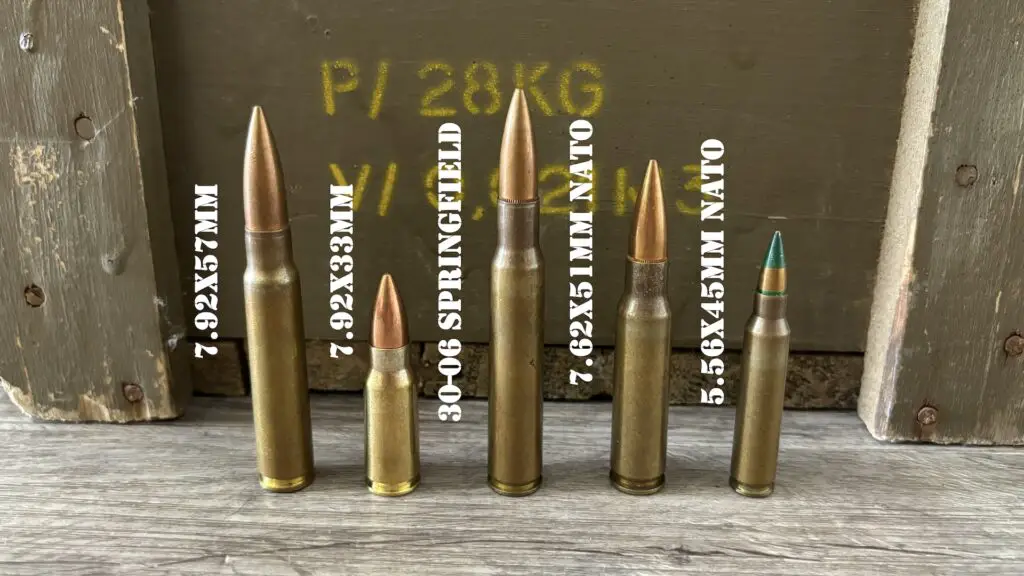
Initially adopted in the American M-14 military rifle, other NATO countries soon adopted the new round for their service rifles (like the G-3 and FN-FAL) and machineguns in the ensuring years.
On the civilian side, Winchester saw the potential of the round as a hunting cartridge and introduced the extremely similar 308 Winchester for hunters and shooters in 1952.
The 308 Winchester cartridge essentially duplicates the original ballistics of the 30-06 from the shorter case due to powder advancements. The cartridge was originally designed to push a 150 grain projectile at about 2,700 fps.
Modern factory loads fired from a rifle with a long enough barrel can push that 150-grain bullet at over 2,800fps, will fire a 165-grain bullet at velocities approaching 2,700fps, and can propel a 180-grain bullet at just over 2,600fps.
In the years following its introduction, both the 308 and 7.62×51 versions gained a great reputation for high accuracy potential and good stopping power, both in sporting rifles and in military use.
The cartridge did not have a long life as the primary military cartridge in NATO countries, as the 5.56x45mm NATO in the M16 rifle took over in the 1960s. The cartridge is still widely used in machine guns and more specialized weapons, such as precision rifles for designated marksmen and snipers.
In fact, the .308 Winchester remains to poster child for a sniper rifle cartridge due to its longstanding association with the M24 and M40 rifles used by the US Army and Marine Corps for many years.
In the hunting fields, the .308 Winchester did not suffer the same fate.
On the contrary, it eventually overtook the .30-06 Springfield in popularity and is now one of the most popular hunting cartridges in the world.
308 vs 8mm Mauser Cartridge Sizes
The two rounds are easy to tell apart from one another when you put them side to side.
The differences begin with the bullets in use; the American 308 Winchester uses .308″ diameter bullets while the German cartridge uses .323″ width bullets.
Next, they use different case lengths.
Like the American 30-06, the 8 mm Mauser cartridge is the archetype of a standard length action round while the newer American 308 Winchester is the poster child of a short action cartridge.
The 308 has a case 2.015″ in length, a rim diameter of .473″, and a maximum length of 2.81″.
The 8x57IS has a 2.24″ long case, stands on a rim .473″ wide, and has an overall length of 3.25″.
The shoulder angles are quite similar: 20 degrees for the .308 and 19.1 degrees the 8mm Mauser.
The .308 cases contain about 56 grains of water, compared to the 63.1 grains for the Mauser cartridge (roughly 13% more room for powder in the German design).
This is offset to a certain degree by the higher maximum chamber pressure of the younger cartridge: 56,560 psi according to C.I.P. and 35,000 psi according to SAAMI for the 8mm Mauser vs. 60,191 psi according to C.I.P. and 62,000 psi according to SAAMI for the Winchester round.
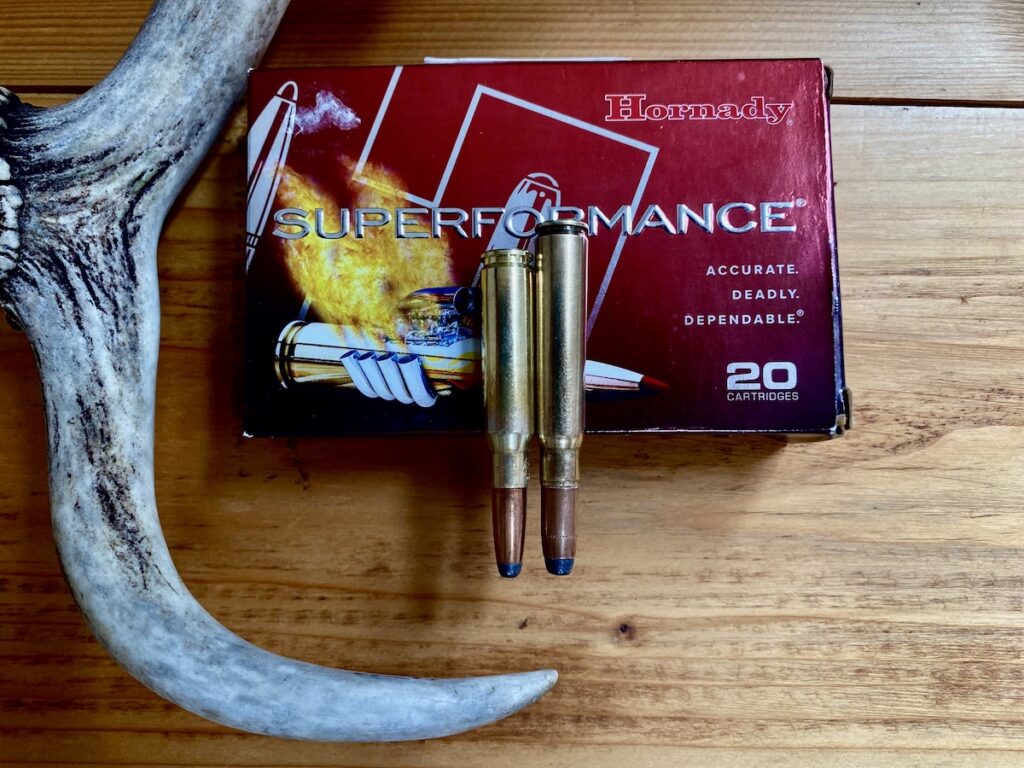
The stark contrast in pressures for the 8mm round between SAAMI and C.I.P. is due to the fear of loading the wrong “subtype” of the metric round on behalf of the American authorities. The larger powder room gives the German cartridge the potential for higher muzzle velocities for bullets of identical weight.
The additional powder burnt can also lead to a slightly stiffer recoil of the 8x57IS in comparison to the .308 Win on average. The short action round has roughly 5-10% less kick, depending on the given load.
Both rounds are a good fit with rather short barrels, where there’s less room for complete powder burn. The barrels of both can be a few inches shorter than those of faster big game cartridges like the .30-06 Springfield, the 7mm Rem Mag, the 7x64mm Brenneke, or the 300 Winchester Magnum cartridge.
This can come in handy if you hunt in tight quarters or you like to add a silencer to the muzzle.
A downside of the lower muzzle velocity of both rounds compared to some others is the shorter effective range, especially with monometal bullets. Those often need 2,000 fps for reliable expansion. Start a bullet slower, and it will fall under that threshold earlier. But in regards to this comparison between the 8x57IS and the .308 Win, there’s no practical difference, since velocities are quite similar.
Although sleek bullets are all the rage in today’s shooting world because of high BC values, some hunters do prefer the larger frontal area of bigger bullets for a higher knock down effect.
It’s often woods hunters that tend towards larger diameters. In tight quarters, a sleek bullet provides no advantage, since the form factor of a bullet doesn’t have significant affect on trajectory or retained energy inside 300 yards or so.
The 8mm’s frontal area is 0.0819 square inch, compared to the 0.0745 square inch of .308 inch diameter bullets. This means a 10% larger frontal surface of the .323 inch diameter bullets.
8mm Mauser vs 308 Ballistics
Now we’ll dive into the relative ballistic performance of these two cartridges.
In order to conduct as close to an “apples to apples” comparison as possible, I selected two factory loads for each cartridge from the same manufacturer using the same bullet.
First we have a load with lighter all copper TTSX bullet from Barnes in their VOR-TX Euro/International line shooting a 160 grain TTSX in the 8mm Mauser (.400 BC) and a 150 grain TTSX for the Winchester cartridge (.420 BC).
As this is a European load, it is loaded to the C.I.P specs for both cartridges. This is especially important to maximize 8mm Mauser performance with factory loads since American manufacturers usually load the 8x57IS to much more sedate velocities due to fear someone might stuff them in a gun with an I-bore for the .318 inch bullets of the 8x57I/P88.


The American cartridge takes full advantage of the higher BC and faster muzzle velocity in this weight range. The end result is a flatter trajectory and less wind deflection.
150 grain projectiles are often considered ideal for the .308 Winchester, offering a good balance between weight and velocity. Still, the 8mm is no slouch either and both rounds measure up pretty well against each other.
If your hunting revolves around deer sized game with occasional bigger animals (all inside 400 yards), both of these Barnes loads will bring your meat to the table.
Next, we’ll take a look at factory loads for Sellier and Bellot’s HPC (hollow point capped) bullet, a heavier lead core bullet. Bullet weights are 196 grains for the German cartridge (.554 BC) and 180 grains for the .308 (.546 BC). This comparison highlights the capability of the 8mm round to launch heavy bullets.
The bullets have a rather high BC, which helps with minimizing drift and drop.


Comparing full house 8mm Mauser loads with heavy bullets against a similar .308 load demonstrates the strengths of the German round. It’s not built for shots much longer than 400 yards, but it’s highly effective for many critters at moderate ranges.
For truly heavy game with thick bones, high weight and sturdy material can come in handy. Shots are often shorter, so the more arching trajectory of heavier bullets is of little concern.
Momentum, weight retention and sectional density are more important for penetration than just muzzle velocity. This is a spot where loads with 180-200 grain copper bullets such as the eXergy from S&B (180 grain in .308, 196 grain in .323 diameter bullets) can shine. To sum it up, they don’t fly fast or flat, but penetrate better than most.
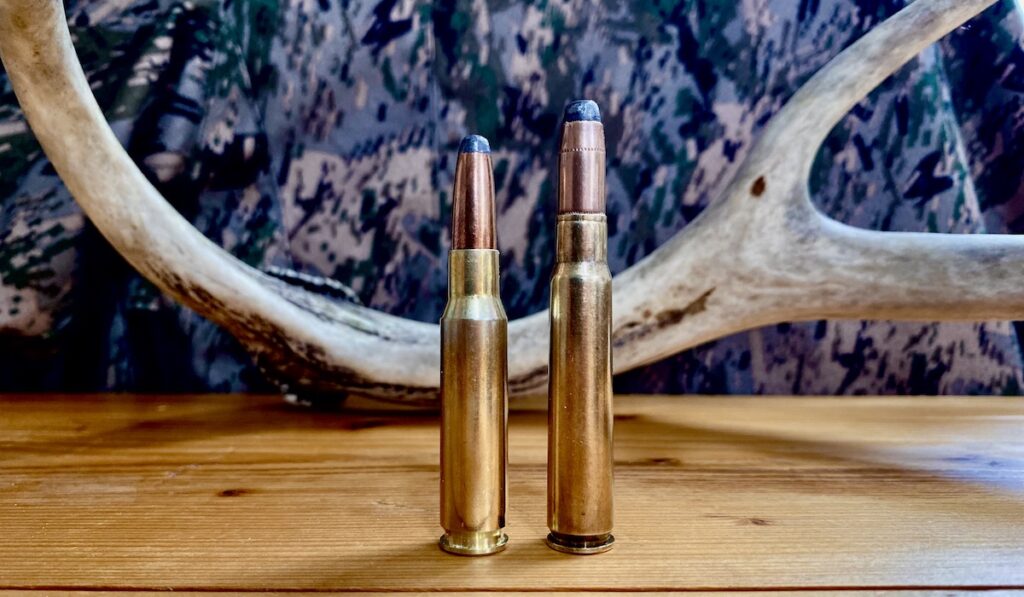
Ultimately, both rounds are really close in performance, and you will likely never regret choosing one over the other when using them within their limits.
For those who want to experiment with the 8mm Mauser, there are a few projectiles with BC values over .600. An extreme example is the .323 caliber 225 grain Cutting Edge MTH (Match-Tactical-Hunting) with a .640 BC. But the limited powder charge and somewhat slow resulting velocity of the 8×57 with such a long, heavy, high BC bullet might very well leave the shooter underwhelmed. The bullet is better placed upon a 8mm Remington, 8x68S or .325 WSM case.
I mentioned the weaker I-bore version of the 8mm Mauser earlier (the 8x57I or Patrone 88 from 1888). The rimless version is fading into obscurity, but the rimmed 8×57 IR still exists though.
The following ballistics for the cartridge with a 196 grain round nose cup and core bullet demonstrate the capabilities of the rimmed 8mm Mauser cartridge. Only a few other loads exist, but the lower velocities compared to the S-version pair great with the softer bullet construction. The bullet has a BC of .236.

As you can see, this is a different class of performance altogether. The old version is closer to the power level of the .30-30 Winchester or the .32 Winchester Special than the 308. It’s sufficient for close shots in the deer woods, for baited/treed black bears or wild boars at the feeder, but not nearly as versatile in regards to medium range hunting and larger critters.
Still, I enjoy using the old version from time to time.
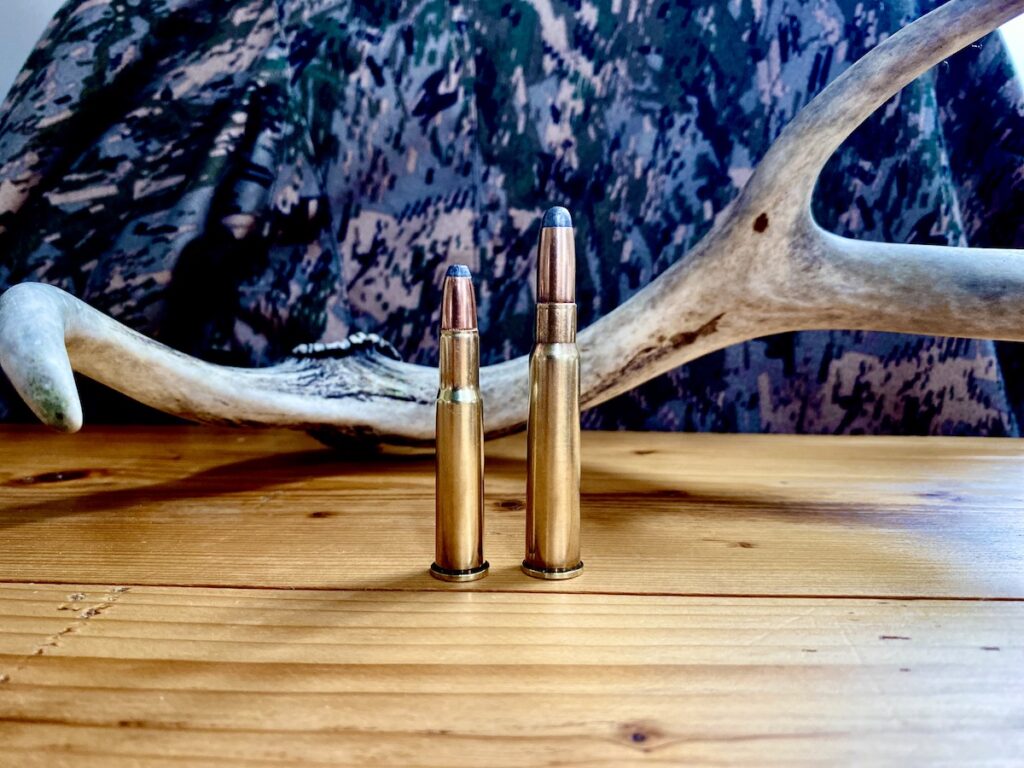
308 vs 8mm Mauser Ammo
While not rare, the 8x57mmIS is nowhere near as ubiquitous as is the .308 Win. This is even more so if you only look at the American ammo market, where only a handful of different loads for the 8mm round are available.
The situation is different in the German or European market however and you’ll find more than a sufficient number of different loads for the German cartridge. Additionally, a few manufacturers from America offer ammo in designated “euro”-product lines.
All told, some 40-50 different factory loaded ammunition choices exist from European ammo companies ranging from plinking or training rounds with bullets weighing 123 grain (Norma Jaktmatch) over various bullet types weighing 160 to 200 grain, to the heaviest projectiles at 220 grain (S&B loaded Sierra Game King).
You can get cup-and-core bullets, bonded lead core bullets, and monometal copper projectiles for the cartridge. While there’s not necessarily a vast selection of 8x57IS ammunition, it’s still pretty common and easy to find ammunition for.
On the other hand, all the big American retailers offer hundreds of different 308 Winchester factory loads from all the household brands such as Hornady, Remington, Winchester, Browning, Federal, Speer, Norma, and many, many more. Virtually every bullet type you can think of is available in the .308 caliber in factory ammunition.
Reasonably priced military surplus ammo used to be somewhat common for both rounds, but that’s sadly no longer the case for either one.
The situation is very similar for .308″ and .323″ component bullets as is the case for factory ammo.
Once again, almost every bullet type you can imagine is available in .308 caliber ranging from 71 grain plinking bullets from Prvi Partizan and ending with 250 grain A-Tip bullets from Hornady (though the practical range useable for the twist rate and powder volume is more like 110-200 grains).
.323″ bullets aren’t exactly rare, but again, the winner of this competition comes from America.
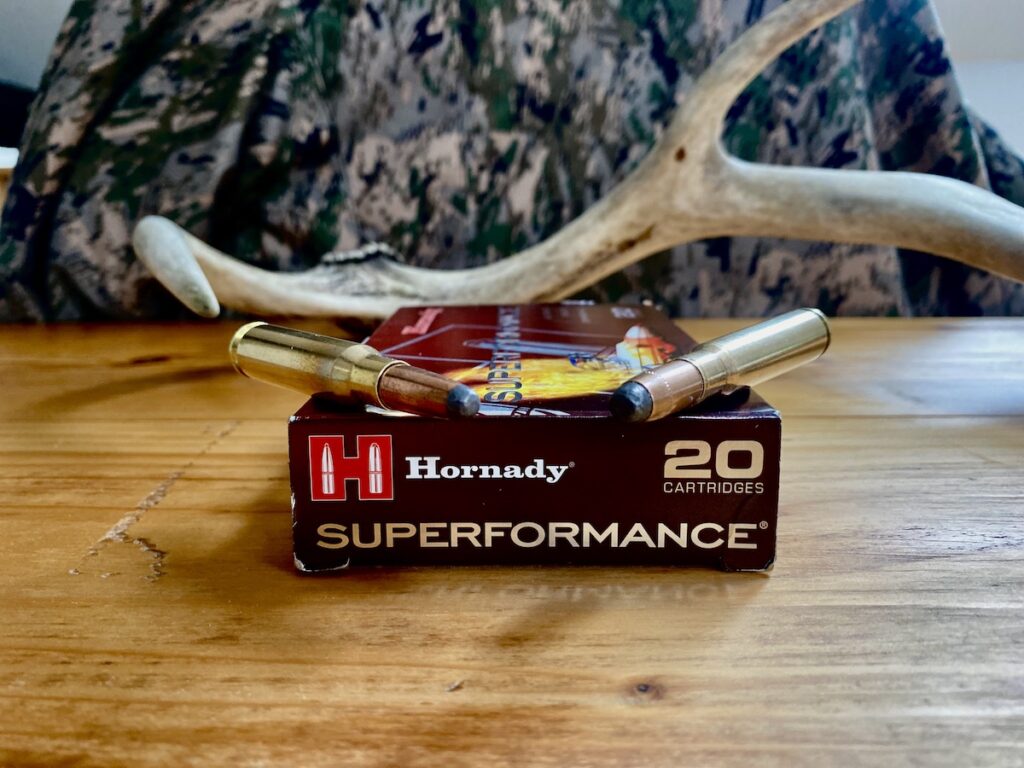
308 vs 8mm Mauser Rifles
As with the ammunition, the 308 Winchester is a clear winner and the 8mm Mauser cannot hold a candle to the 308 in terms of sheer rifle availability.
Almost every new gun is intended for anything resembling big game hunting, manufactured by any company on this planet, will be chambered in .308 Winchester. New or used, cheap or expensive, bolt action or autoloader, or even break action guns, beautifully crafted pieces of art or downright ugly tools: you can get basically any rifle you fancy in .308 Winchester.
Among other companies, Savage, Ruger, Tikka, Winchester, Sako, Blaser, Sauer, Remington, Howa all produce rifles in that chambering. It’s a staple in popular rifles models from American companies like the Winchester Model 70, Remington Model 700, Savage Axis, and Ruger Hawkeye.
The same cannot be said for the 8x57mmIS. While there’s no actual shortage of gun options, most will be European rifles.
If that doesn’t appeal to you, you might still find an American rifle on the used gun market. For instance, Remington made their Model 700 rifle in 8mm Mauser for a time. Same with Savage with their 110.
But don’t scoff at the thought of European guns. Blaser’s R8 straight pull rifles are renowned for functionality and quality. Sauer and Mauser built beautiful and durable weapons.
Buy one of them and you’ll never need to buy a new gun, unless you want to. Cheaper guns from the same companies like a Sauer 100 or a Mauser M18 (along with military surplus German and even Turkish Mauser rifles) open the door for more price-conscious shooters who want to explore the 8x57IS. Other manufacturers from Europe such as Sako, Tikka or Haenel also built 8mm Mauser rifle.
Those who want a Mauser action of some sort will be happy to learn that simple Mauser 98-style rifles from various smaller companies aren’t expensive either.
I think the 8mm Mauser has an edge in availablity of classy break action guns such as drillings and single shots chambered for the rimmed 8mm Mauser. While those guns do work with a rimless case in modern models, there’s a reason for the existence of rimmed sister cartridges.
Older guns were just more reliable when the rim of the case was used for extraction. In my humble opinion a combination gun needs a rimmed metric round to carry the special flavor of this type of guns, anyway.

308 vs 8mm Mauser: Which Is Right For You?
Both the .30 caliber round and the .323 caliber cartridge could be depicted in any dictionary in the all around hunting cartridge section.
Both check all the boxes for general hunting and shooting purposes out to a quarter mile or so: reasonably flat shooting, hard hitting bullets for the biggest ungulates, versatile bullet weights for most any target species, sufficient to great selection of bullet constructions in both loaded ammo and as component projectiles, and moderate prices for rifles and ammunition.
As all-purpose cartridges with moderate recoil, both rounds are fantastic choices for all the non-dangerous game the European and the American continent are roamed by.
Red deer and wapiti, fallow and whitetail deer, sika stags and pronghorns, chamois and mountain goat, and mufflon and dall sheep. All these will go down quickly and without much fuss if struck in the vitals by a bullet fired from one of the two cartridges.
Even brown bears won’t like a well placed controlled expansion projectile, although both rounds are not exactly an ideal choice for the largest predators on both continents.
Moose, though large in the truest sense of the word, can be very effectively taken with a .308 Win or a 8x57IS.
If you look at Africa, it’s obvious the thick skinned beasts such as buffalo overmatch the two cartridges. Every other hoofed animal, even the enormous eland, is not too much. Down will go the notoriously tough zebra or the hardy sable when hit right.
There are few better plains game rounds then the two.
The 8x57IS in particular earned a stellar reputation among farmers and hunters in German colonies and the successor states, especially when using a heavier bullet. While not perfect for the clawed large cats, the hunting of those relies on precise shooting, which is much more likely to be accomplished by a nervous guest hunter using a moderate recoiling cartridge such as the two military rounds (where they’re legal for that sort of hunting).
South America, Australia and Asia offer loads of hunting opportunities where a hunter can feel comfortable and well armed with a .308 Winchester or a 8mm Mauser. Many deer, black bear, sheep, goat or antelope species alongside wild boar might be addressed with a rifle chambered in one of the two rounds at hand.
Well constructed bullets will kill them as dead as with any other cartridge choice of the all around caliber class.
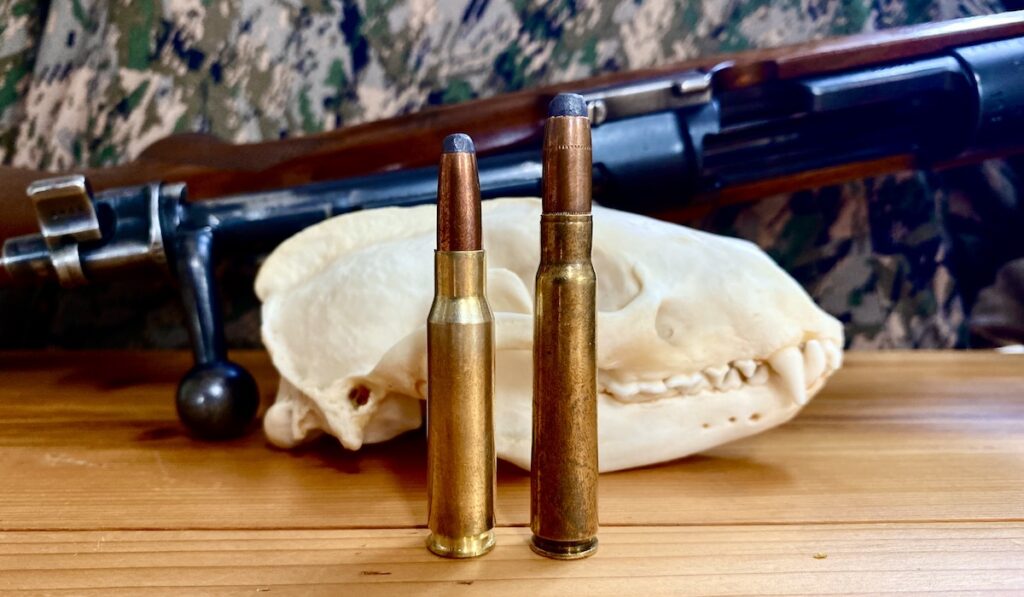
Mountain hunting is not exactly a field where the .308 and the 8x57mm are at their best. But with range finders, dialing turrets and good marksmanship, both are capable choices in many high country hunting scenarios. The same goes for wide open flatlands such as wide stretching fields or grasslands.
Driven hunts, like they are conducted in broad ranges of Europe, are a different story. Shooting distances are much closer. Hunters in Spain, Poland, France, Belgium, Romania Germany, Sweden and many others find both rounds useful and powerful. So will hunters pursuing driven deer in the USS.
For recreational or competitive shooters, the .308 certainly has more appeal.
While the 8mm Mauser can be highly accurate, it stems from a different time. It lacks a few characteristics that enhance accuracy potential, making it a little harder to get superb accuracy from it.
For hunters, it’s plenty accurate, even from old guns.
Modern rifles will help but can’t change the dimensions of the case and the chambers towards what we know helps with consistency (tight chambers, steeper shoulders, little body taper, for example). When your shots will be not much longer than 350 yards, rest assured that you won’t miss because of your cartridge choice.
After spilling so much “digital ink” on the characteristics, strengths and weaknesses of the two former military cartridges, let me state this: both the 8mm Mauser and the .308 Winchester are proven winners, standing beyond any doubt about their usefulness for big game hunters.
Although 7mm rounds seem to be on the rise for use as the designated big game cartridge, both cartridges will remain popular choices for several generations of hunters to come.
While both check a lot of important boxes, they’re not completely interchangeable.
The 8mm Mauser, being a standard length action cartridge with a bit more room for powder to propel slightly larger caliber and heavier bullets than the .308 Win does, is probably a better fit for the larger game species.
That doesn’t mean the American round will fail at the task of bringing down heavyweights, but the bigger bullets traveling at similar speed than lighter bullets carry more momentum that might give some room for error in certain situations.
On the other hand, the .308 Winchester has a huge advantage with its much better availability in ammunition, components and guns. It’s a simple truth that many people tend to go the route of least resistance, so picking up a .308 rifle makes things a lot less complicated.
While there’s a tremendous amount of overlap in their best uses (and they’re both a good choice for many applications), I think it’s fair to say the 308 Winchester is the better choice for situations where longer shots are more likely.
Likewise, I think the 8mm Mauser is the better choice for shorter ranged shots on larger game where its larger caliber and heavier bullets are more useful.
Since it also does practically everything the Mauser cartridge will do for you, there’s little reason for owning a 8mm Mauser beside having a soft spot for the rather unusual (at least in North America).
In Europe, you will not encounter any problems when you own a 8x57IS. The advantage of short action cartridges and subsequent weight reduction in guns is overblown, in my opinion. Yes, it’s a plus for mountain hunters in the toughest terrain, but a standard length action will not present major issues otherwise.
In the end, it’s hard to crown a winner between the 8mm Mauser vs 308 Winchester.
When it’s all said and done, it’s hard to give a nod towards one or the other if you’re looking at ballistics and capabilities for big game hunting only. Once you add precision shooting and logistics of obtaining ammunition to the equation though, you should lean towards the American .308 Winchester.
Ultimately, I personally think you can’t really go wrong with both former military cartridges.
NEXT: BEST 6.5 CREEDMOOR AMMO FOR HUNTING ELK, DEER, & OTHER BIG GAME
NEXT: BEST GIFTS FOR HUNTERS
Enjoy this article comparing the 8mm Mauser vs 308 Winchester cartridges? Please share it with your friends on Facebook and Twitter.
Make sure you subscribe to The Big Game Hunting Podcast and follow The Big Game Hunting Blog on Facebook, Instagram, Twitter, and YouTube.
John McAdams is a proficient blogger, experienced shooter, and long time hunter who has pursued big game in 8 different countries on 3 separate continents. John graduated from the United States Military Academy at West Point and is a veteran of combat tours with the US Army in Iraq & Afghanistan. In addition to founding and writing for The Big Game Hunting Blog, John has written for outdoor publications like Bear Hunting Magazine, The Texas State Rifle Association newsletter, Texas Wildlife Magazine, & Wide Open Spaces. Learn more about John here, read some of John’s most popular articles, and be sure to subscribe to his show: the Big Game Hunting Podcast.

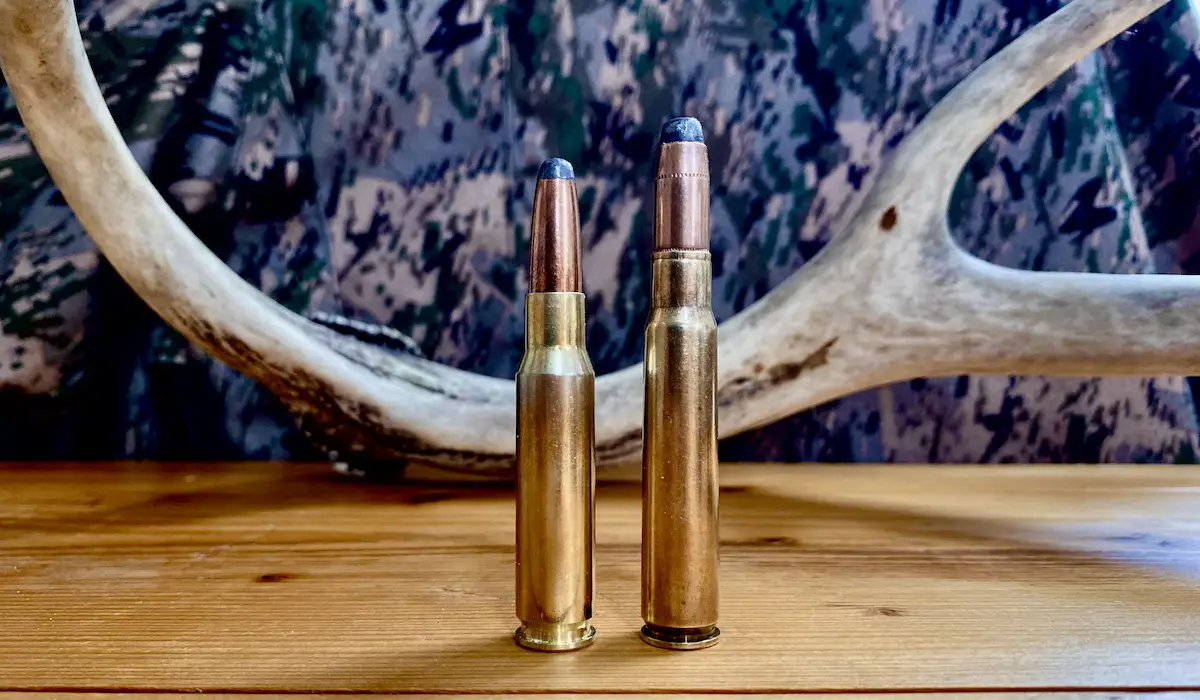

John;
I’ve shot both elk and deer with both cartridges. They Work – and as you intimated are six of one /half dozen of the other. I will say that my preference on elk is for the 8mm. Heavier bullets work better there. Toss in the 30-06 and the 7.5×55 Swiss and you’ve got a pile 0f near 30 cals that can do the job. I’m very enamered with the 7.5×55 Swiss. Near perfect cartridge design for a 30.
Speaking of the 7.5×55 Swiss, I think you’ll like my upcoming podcast on the “other” 30 cals that’s coming out later this month…